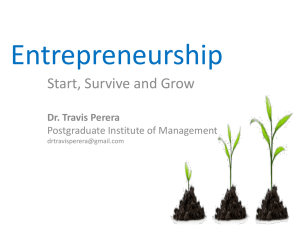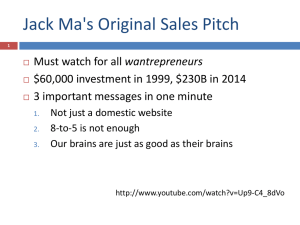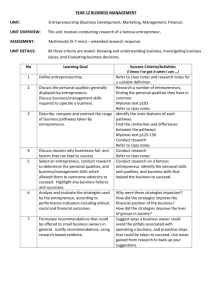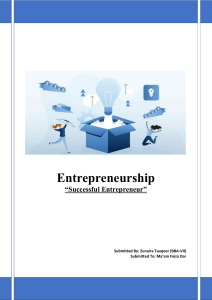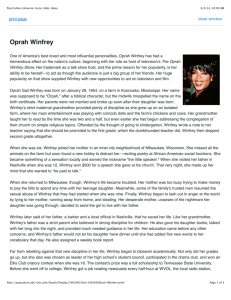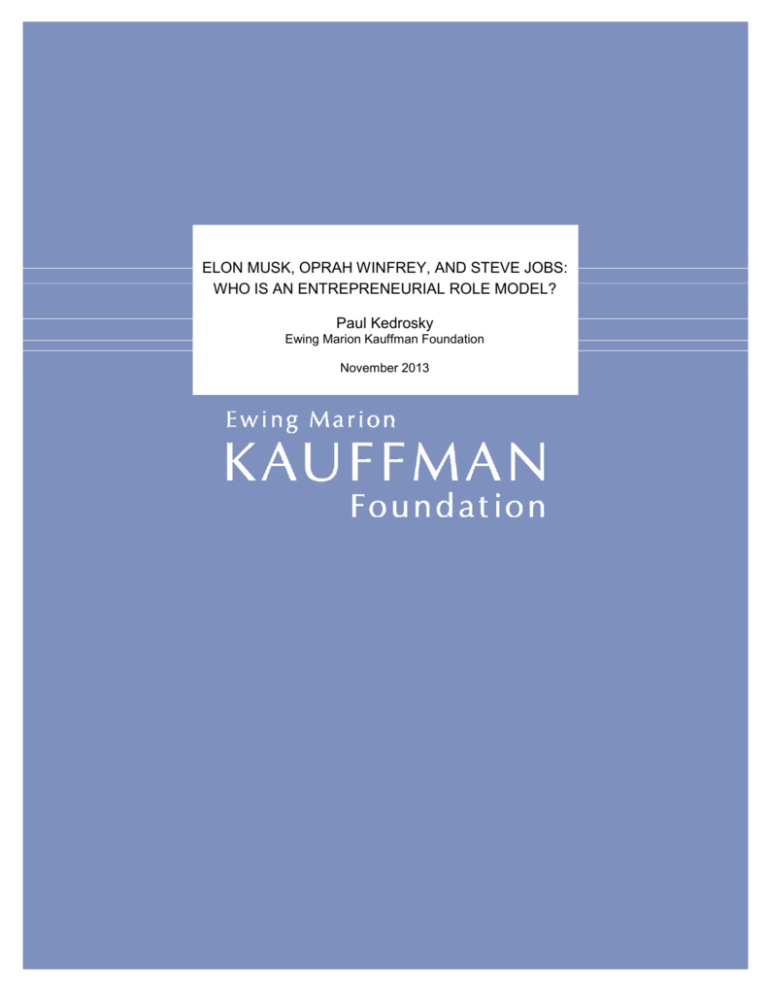
ELON MUSK, OPRAH WINFREY, AND STEVE JOBS:
WHO IS AN ENTREPRENEURIAL ROLE MODEL?
Paul Kedrosky
Ewing Marion Kauffman Foundation
November 2013
ELON MUSK, OPRAH WINFREY, AND STEVE JOBS:
WHO IS AN ENTREPRENEURIAL ROLE MODEL?
Paul Kedrosky
Ewing Marion Kauffman Foundation
November 2013
© 2013 by the Ewing Marion Kauffman Foundation. All rights reserved.
ELON MUSK, OPRAH WINFREY, AND STEVE JOBS:
WHO IS AN ENTREPRENEURIAL ROLE MODEL?
INTRODUCTION
Role models and imitation are important in entrepreneurship. In an October 2013 paper,
“Getting the Bug: Is (Growth) Entrepreneurship Contagious,” we looked at the role of
imitation in spurring entrepreneurship. In a related effort, this paper looks at
entrepreneurial role models through the lens of which entrepreneurs are most readily
identifiable by U.S. residents.
BACKGROUND
Role models are important in many professional activities. They are a part of learning
and progressing in fields like law, medicine, and engineering.1 Role models legitimate
an activity—across genders, ages, races, and socioeconomic groups—and provide
practical, tested examples of best practices.
Role models play a significant role in business in general, and in entrepreneurship
specifically.2 They are particularly crucial given the underrepresentation of women and
non-Caucasians among entrepreneurs overall, and among growth entrepreneurs in
particular. 3
It is unclear, however, who typical Americans identify as entrepreneurial role models.
Are they contemporaries? Do they identify anyone at all? It would be useful to
understand who they recognize and how that varies by geography, gender, race, and
income.
DATA
This study surveyed 1,000 U.S. residents over age 18 about their knowledge of various
entrepreneurs. Specifically, the survey asked respondents which people from a list of
five candidates were entrepreneurs.4
The survey was conducted August 18–22, 2013, using Google Consumer Survey.
1
For example, see Scott Wright, Annie Wong, and Carol Newill, “The impact of role models on medical
students,” Journal of General Internal Medicine 12, no. 1 (1997): 53–56.
2
Howard Van Auken, Fred L. Fry, and Paul Stephens, “The influence of role models on entrepreneurial
intentions,” Journal of Developmental Entrepreneurship 11, no. 2 (2006): 157–67.
3
Robert Hisrich and Candida Brush, “The woman entrepreneur: Management skills and business
problems,” Journal of Small Business Management 22, no. 1 (1984): 30–37.
4
The people named were Thomas Edison, Sam Walton, Oprah Winfrey, Steve Jobs, and Elon Musk.
RESULTS
Overall Awareness
The first figure shows the nationwide results from the survey across the five named
individuals.
Fig. 1. Overall Awareness of Entrepreneurs
Steve Jobs
52.8% (+3.1 / -3.1)
Oprah Winfrey
38.9% (+3 / -3)
Sam Walton
38.1% (+3 / -2.9)
Thomas
Edison
None of the
above
Elon Musk
33.3% (+3 / -2.8)
24.7% (+2.7 / -2.6)
12.9% (+2.2 / -1.9)
Slightly more than half of respondents were familiar with Apple founder Steve Jobs.
Media entrepreneur Oprah Winfrey followed at 38.9 percent, with Walmart founder Sam
Walton only slightly behind. Next was inventor Thomas Edison, and trailing the rest was
Tesla and SpaceX founder Elon Musk. Notably, Musk, despite his much-publicized
recent successes, trailed even the “None of the above” category, with 12.9 percent
awareness.
To put these levels of recognition in context, compare Americans’ awareness levels of
entrepreneurs with those of other public figures. Awareness analysis firm Q Score says
tennis professional Roger Federer is known by 38 percent of U.S. consumers, while
former President Bill Clinton is known by 95 percent of U.S. consumers. Deceased
actress Marilyn Monroe is known by 96 percent of consumers. With the exception of
Jobs, who was responsible for arguably the most influential technological innovation in
the past quarter century, Americans’ entrepreneur awareness pales compared to other
influential public figures.
Geography
Turning to geography, the results are as shown in the following table. (Darker green
shades denote higher frequencies, and darker orange shades denote lower
frequencies.) The strongest differences depend on the individual entrepreneur, not the
location of the respondent. But there are nuances, with Oprah Winfrey much more likely
to be known in the Midwest and South, unsurprisingly, given her background.
Table 1. Awareness by Respondents’ Geography
Gender
Some striking differences are associated with gender. While men and women reported
similar levels of recognition with respect to Jobs, Walton, and Edison, they were far
apart in their perceptions of Musk and Winfrey. Far fewer men saw Winfrey as an
entrepreneur than did women, whereas many more men than women were aware of
Elon Musk’s entrepreneurial efforts.
Table 2. Awareness by Respondents’ Gender
Why the differences among men and women? At a superficial and stereotyped level—
and this may be the most compelling explanation—men must see Winfrey as a TV
figure first. Similarly, perhaps women (in general) are less aware of Elon Musk because
his recent successes have been in automobiles and space flight, domains to which men
have been more attracted in the past. This difference is somewhat disappointing—we
benefit from all entrepreneurs, but disproportionately so from growth entrepreneurs like
Musk—but it does point to the need for differentiated role models across gender lines.
Income
A number of things were apparent from looking at the income levels of respondents.
First, Apple founder Steve Jobs had broad recognition across all income groups. This is
understandable given his general notoriety based on Apple’s success. Second, Oprah
Winfrey was best known as an entrepreneur by the higher- and low-income strata. This
reflects, perhaps, aspirational awareness among low income respondents, and
knowledge of her business success among the higher income respondents. Third,
Walmart founder Sam Walton was best known as an entrepreneur by higher income
groups. Many do not know the entrepreneurial history of Walmart, despite its
prominence, but it is often written about in the business press whose audience skews to
higher incomes.
Table 3. Awareness by Respondents’ Income Levels
CONCLUSIONS
This paper has tried to investigate entrepreneur role models in the United States. The
proxy used was survey data of U.S. residents on their awareness of five prominent
entrepreneurs, both contemporary and historical.
It is clear that individual entrepreneur awareness is low in the United States, lower than
might be expected given the country’s reliance on such individuals in its economic past
and present. Levels of awareness of entrepreneurs significantly lagged those of
politicians, celebrities, and athletes. While unsurprising, it also represents an
opportunity, given that entrepreneurial role model awareness can play an important role
in entrepreneurial activity.
This study furthers other Kauffman Foundation research into the social network aspects
of entrepreneurship. Imitation, role models, and awareness are hugely important forces
in entrepreneurial activity, yet they are ill-understood and often neglected for more
formal channels of entrepreneur creation. This is unfortunate, but there are many
opportunities to remedy the problem by rethinking how we help prospective
entrepreneurs become more aware of the entrepreneurs around them.




